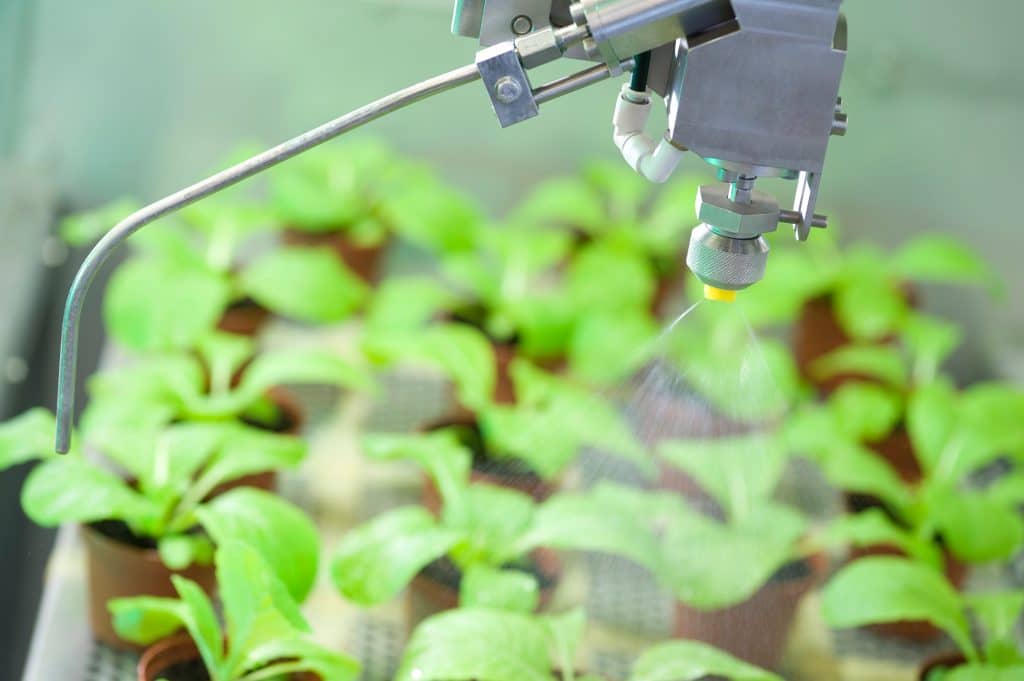In the first part of this three-part article, we look at the historical and recent evolution of crop protection. In part two, we’ll examine the challenges in creating crop protection products, and in the final piece, we’ll present current trends and future outlook.
Crop protection products receive a great deal of attention in the media today, and it’s not always easy to separate fact from fiction. One thing we can say with certainty is that crop protection has evolved enormously over its history, and that we have depended on crop protection products for our very survival for dozens of generations.
[tweetshare tweet=”We depend on crop protection products for our survival.” username=”EuropeanSeed”]
“We know that an adequate, reliable food supply cannot be guaranteed without the use of crop protection products,” observes Will Surman, spokesperson for CropLife International, the global advocate for the plant science industry. “Today’s food crops must compete with 30,000 species of weeds, 3,000 species of nematodes and 10,000 species of plant-eating insects.”
Indeed, it’s a stark reality check to consider that even with the world’s newest technologies, notes Brian Carroll, as much as 40 per cent of the world’s potential harvests are lost to damaging pests. “These pests include weeds, which steal nutrients, water and sunlight from crops,” explains the spokesperson for Monsanto Europe. “And without modern crop protection tools, including herbicides, current crop losses could double.”
Some people think that crop protection involves farmers simply applying chemicals to their crops to manage pests, but that’s not the case, Surman explains. “If farmers are to tackle crop pests sustainably they need to use a wide variety of tools and techniques through an integrated pest management (IPM) strategy,” he says. “IPM is a system of prevention (anticipating pest threats and taking action to prevent populations from growing to a destructive level), monitoring (using both new technology and traditional practices to keep a close eye on weed, insect and disease threats in the field) and management – using many different tools and techniques to safely control pests when they threaten to destroy our food supply.”
Origins of crop protection
Before we look at more recent developments in the field of crop protection, let’s first take a look back at its long history. It’s not generally known that human use of innovative crop protection products goes back several millennia, with the first recorded insecticide being referenced about 4,500 years ago – the Sumarians use of sulfur compounds to control insects and mites.
From then until now – in addition to crop management methods like rotation, removing morning dew to curb fungal disease spread, tillage – ancient farmers tried magic, prayer, living a virtuous life, rituals and more, but they came to rely on crop protection products. From ancient times to today, some examples are pyrethrum from dried Chrysanthemum flowers and nicotine extract from tobacco plants (see sidebar for more).
From 1750 to about 1880, according to CropLife, farmers began using crop protection products more widely, and international trade began to make both the use of plant- and metal-based insecticides more common. “Until the early 1900s, Europe and the U.S. used compounds made with sulfur, iron, copper, arsenic and sodium to control weeds in cereal crops and fungus in grapes,” notes Jan C. Zadoks and H. Waibeu in an article in the Netherlands Journal of Agricultural Science. They explain that an organic arsenic compound named Salvarsan, invented in 1907, led to the development of organic mercury compounds; these substances were used extremely successfully to disinfectant seeds from disease. Zadoks and Waibeu add that the creation of organic pesticides, beginning with DDT, were “widely applied during World War II for control of malaria and typhus,” and after World War II came the creation of more crop protection products such as carbendazim.

Modern industry changes
In general, Carroll notes that nowadays farmers have access to a much wider variety of crop protection tools, including state-of-the-art pesticides, advanced data analytics and precision technologies. “New technologies have improved profiles – biologically and environmentally,” agrees Dan Turner, media relations lead at Dow/DuPont.
However, because so much biochemistry exploration has been done, a need has developed to cast a much wider ‘net’ in the creation of new products, notes Dr. Rainer Preuss, Vice President of Global Strategy & Portfolio Management at BASF Crop Protection. Indeed, the average number of new molecules currently researched in the eventual registration of one new crop protection product has almost tripled from 52,000 in 1995 to 160,000 today. Surman explains that whilst this is due to an increasing difficulty in finding new product leads, it also reflects increased screening of product candidates. “The screening process is better able to consider properties, such as human and eco toxicity, early in the process,” he notes, “which ensures only the development of products that meet strict regulatory standards.” Preuss adds that according to a recent study by research firm Phillips McDougall, the average lead time between the first synthesis of a new crop protection molecule and its subsequent commercial introduction has also increased.
[tweetshare tweet=”The average cost of developing a new crop protection product is over 200 million Euro” username=”EuropeanSeed”]
All these factors have resulted in higher product development costs. Again, Preuss quotes the Phillips McDougall study that finds overall costs of developing a new product have risen from $152 million USD (€115m) around 1995 to $286 million USD (€215m) in the period of 2010 to 2014. Surman adds that “since the turn of the century, the crop protection industry has increased its spending on crop protection product safety testing by 118 per cent. The crop protection industry spends an average of $71 million on toxicology and environmental chemistry tests for every single crop protection product that is brought to market to ensure human and environmental health and safety.” Preuss adds that apart from medicines, plant protection products are the most thoroughly scrutinized substances on the planet. “About 800 requirements need to be addressed and more than 200 studies are filed for a registration, and sale without approval from national authorities (registration) is not possible,” he notes. “A modern crop protection product must show very reliable action, be well-tolerated by cultivated and beneficial organisms (selectivity), and have favourable toxicological properties. Furthermore, it must rapidly degrade with adequate duration of action, it needs to have a user-friendly formulation and added value for producers and users.”
“With these costs, scale for innovation is extremely important, notes Camilla Corsi, head of crop protection research at Syngenta. “The market will remain extremely competitive. The major players will be more efficient, investment will be supported and R&D will continue. We fully expect to also see the continuing strong presence of generic players in almost all markets around the world. The industry consolidation [Editor’s note: more about this in Part 3] puts pressure on R&D, which we meet by leveraging partnerships.”
There has also been the creation of global science-based regulatory framework over the last few decades that closely examines all phases of the pesticides product life-cycle, including proper handling, transport, labeling and the setting of allowable residue levels in food (known as Maximum Residue Limits or MRLs). Surman says it’s essential that the regulatory framework uses an evidence-based approach to understanding the results of using a product, to characterize it and its proposed uses to ensure that the safe use of products will contribute towards sustainable food production.
Specific changes to the crop protection sector include:
- Decrease in application rates. Turner considers this to be one of the most striking developments of the crop protection industry in the modern era. “Very often, we now talk about g/ha instead of the kg/ha that existed in the past,” he says. “Application methods have become much more precise, so that off-target impacts can be avoided. User safety is a predominant goal and leaving no residue on crops is critical to ensure the easy movement of produce around the globe.” Turner gives the example of recent advancements in delivery systems for auxin herbicides (for example, 2,4-D) that have led to products that have virtually no off-target movement. This demonstrates, he says, “that even products over 60 years old can be improved and employed in modern agriculture.”
- More environmental studies. Utz Klages, external communications lead of Bayer’s Crop Science division, notes that significant investments have been made in the last few decades in scientific studies to evaluate the fate of crop protection products in the environment (for example, degradation in soil) and to evaluate potential side effects of crop protection products on non-target organisms such as pollinators. “Crop protection products have improved safety profiles and this goes together with specific modes of action,” he says. “This is linked to the implementation of a strict regulatory framework that guides the registration of new products. The specific modes of action of modern crop protection products pose a risk of development of resistance in disease agents, weeds and insects, and there is much R&D occurring to monitor and forecast resistance development in the target pest to a given mode of action.” One way that resistance is being avoided and efficacy maintained, says Turner, is through companies ensuring active ingredients are placed with the right chemical mixing ‘partner.’
- Decrease in toxicity. A study done a few years ago by the U.S. Department of Agriculture, found that pesticide use in the country peaked in 1981 and has since steadily decreased, “driven by technological innovations and other factors.” As writer Marc Brazeau points out, this should be viewed in concert with the fact that the U.S. population grew from 230 million in 1980 to over 325 million today, while crop yields have increased dramatically. Therefore, we can say that pesticide use has decreased substantially on a per capita and per bushel basis, at the same time, adds Surman, that toxicity levels of crop protection products have dropped and biodegradability has improved. Brazeau states that usage of Class I (highly toxic) chemicals has been almost completely abandoned and has shifted “dramatically away from Category II (moderately toxic) and Class III (slightly toxic) towards Category IV (practically non-toxic).” It is also not well known that organic farmers around the world are allowed to use hundreds of crop protection products, including many chemical agents, to control fungal diseases, insects and weeds (see full category lists created by the Organic Materials Review Institute https://www.omri.org/omri-lists/download)
- Increased demand for seed-applied solutions. “There has been – and continues to be – a rapid progression of improvements in seed application technologies and techniques,” Wurst says. “In addition, the complexity that can be applied to seeds has also increased, with chemicals-based and biologicals-based seed treatments, biological inoculants, functional coatings and colorants that are customizable according to customers’ needs.”
- More social impact studies. Studies are now being undertaken to address societal issues related to crop protection, studies that Turner says are taking new directions and producing results that are challenging to interpret as there are no standard or consistent research protocols to apply.
“The world’s population is expected to reach 9.1 billion people in 2050, up from 7.4 billion in 2016,” says Corsi. “Farmers globally must increase food production 70 per cent, compared to 2007 levels, to meet the needs of the larger population, according to a report from the Food and Agriculture Organization of the United Nations. Innovation in plant breeding is necessary to meet this global challenge, as well as the impacts of climate change.”












